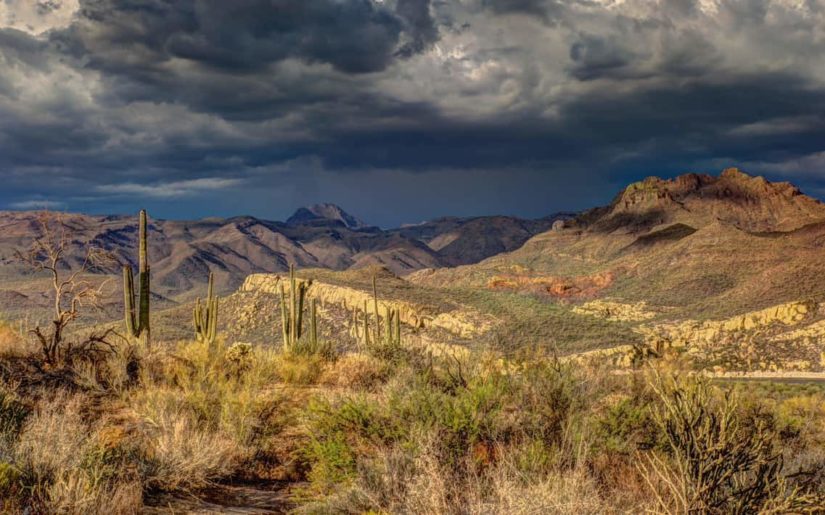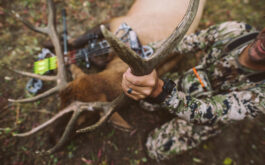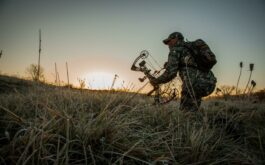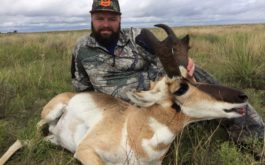Arizona offers beautiful scenery and an array of wildlife including big and small game. Big Game seasons include hunting for elk, mule deer, fall turkey, bighorn sheep, fall bear, mountain lion. Small Game seasons include tree squirrel, cottontail rabbit, pheasant, quail, chukar and blue grouse.
What to Hunt – Big Game
Antelope
Antelope are found mostly in the northern plains. They inhabit high elevation meadows between forested areas, semi-desert grasslands and scattered herds are found in the grasslands of southeastern Arizona. A specific characteristic of the antelope is the white patch on its rump. The top of the buck’s nose is dark and you will typically find a triangular black patch below the ear. The doe doesn’t have this marking but presents a short mane along the top of the neck. These animals are primarily browsers on things such as sagebrush.
Black Bear
In Arizona, black bears are found mostly in woodland habitats including pinyon-juniper, oak woodland, coniferous forest and chaparral. North of the Colorado River the black bear population is quite low.
Bighorn Sheep
The Bighorn population in Arizona consist of both desert and Rocky Mountain races and is estimated at about 6,000 animals. THe cause for this decline was the competition with livestock for food and water and exposure to livestock associated parasites and diseases. This happened primarily between 1850 and 1900. Each year there are between 80 and 100 permits that are authorized (mostly desert bighorns) with hunt success ranging between 90 and 95 percent.
Elk
Elk withstood the impacts of western settlers because they inhabit rougher terrain than other species. They can be found in northern Arizona in fir-aspen and pine-juniper forests. They prefer to graze no weeds, grass, sedges, shrubs, willow and trees that are in season.
Javelina
The collared peccary, or javelina, evolved in South America and migrated north, only recently arriving in Arizona. The collared peccary has one of the largest latitudinal ranges of any New World game animal. They can be found from Arizona to Argentina. In the United States, the collared peccary only occurs in Arizona, Texas, and New Mexico. Javelina enjoy a desert, chaparral and oak-grassland habitat. To better distribute hunters, in 1974 permit-only HAM (handgun, archery and muzzleloader) hunts were initiated and archery hunting was limited to permit-only in 1992. In 2006, Arizona offered Javelina permits for fall seasons as well as spring seasons.
What to hunt – Small game
There are plenty of small game animals to hunt in Arizona, some more popular than others. The least popular animals include: Sandhill Cranes, Band-tailed pigeons, Blue Grouse, Chukar, Pheasant (which can only be hunted in the game management unit 40B, near Yuma), and tree squirrel.
Dove
Arizona is home to some of the best dove hunting in the US. The largest number of birds can be found where there are agricultural crops such as millet, sorghum and sunflower.
The Mourning Dove is the most common and widely occuring game bird in Arizona, recognized by their streamlined grey body and tiny heads. White-winged doves are larger than the Mourning Doves and can be distinguished by a bright blue patch around its eyes, red feet and eyes that range from yellow to orange to orange to red. Collared Doves are the third largest dove found in Arizona following the Rock Dove. They have a prominent black collar around their necks which is where their name is derived from.
Quail
There are three species of quail in Arizona that hunters generally pursue over others. They are Gambel’s, scaled and/or Mearns. The other species who do not receive much hunting pressure are the California quail is found along the Little Colorado River drainage near Springville and the masked bobwhite which is federally listed as an endangered species and is found only on the Buenas Aires Refuge southwest of Tucson.
Cottontail Rabbit
There are three different species of cottontail rabbits in Arizona: the mountain cottontail, eastern cottontail, and desert cottontail. The smallest is the mountain cottontail is found in elevations above 7,500 feet from the Mogollon Rim northward and have relatively short ears. The larger eastern cottontail is found in the mountains of southeastern and central Arizona and the most abundant rabbit, the desert cottontail is found in every county in the state up to elevations exceeding 7,000 feet. Each year the taking of cottontails differs and the Arizona Game and Fish website should be checked.
Where to hunt
Nearly half of the state of Arizona is open to the public. The following areas provide an array of hunting opportunities in rugges topography, beautiful scenic vistas, rich vegetation and wildlife, and a plethora of spots for quiet solitude.
WOOLSEY PEAK WILDERNESS
Woolsey Peak Wilderness covers 64,000 acres of land and is located 32 miles southwest of Phoenix. It provides Sonoran Desert habitat for desert bighorn sheep and mule deer.
Wildlife includes mule deer, bighorn sheep, javelina, and numerous varieties of birds, lizards, and snakes. This wilderness area offers outstanding opportunities for cross-country foot and horseback travel, route finding, and wildlife viewing. There are no marked trails, campsites, or other developed recreational amenities — this area is recommended only for experienced and prepared wilderness visitors.
KAIBAB NATIONAL FOREST
Kaibab National Forest covers 1.6 million acres of land and borders the north and south rims of the Grand Canyon. It also includes more then 300 miles of trails.
Commonly seen large wild animals include white–tailed deer, mule deer, elk, pronghorn, turkey and coyote. Cougar, bobcat, and black bear are seen less frequently.
Common small animals in Kaibab National Forest include chipmunks, ground squirrels and Abert’s squirrels. Less common are porcupines, small lizards, and rattlesnakes. Most common birds are bluebirds, robins, Steller’s jays, nuthatches, flickers and other woodpeckers, crows, various hummingbirds, ravens, and a variety of hawks. Bats also occupy the park.
TONTO NATIONAL FOREST
Tonto National Forest includes 3 millions acres of land and contains eight wilderness areas covering nearly 600,000 acres. It is a popular national forest and attracts nearly 6 million visitors annually.
There are eight federally designated wilderness areas within (or partially within) the Tonto National Forest:
- Four Peaks Wilderness
- Hellsgate Wilderness
- Mazatzal Wilderness
- Pine Mountain Wilderness
- Salome Wilderness
- Salt River Canyon Wilderness
- Sierra Ancha
- Superstition Wilderness
SANTA TERESA WILDERNESS
Santa Teresa Wilderness includes over 26,000 acres of land and is considered to be one of the most remote areas of Arizona. It provides terrain that makes it more difficult to access making it a unique hunting experience for the more experienced outdoors person.
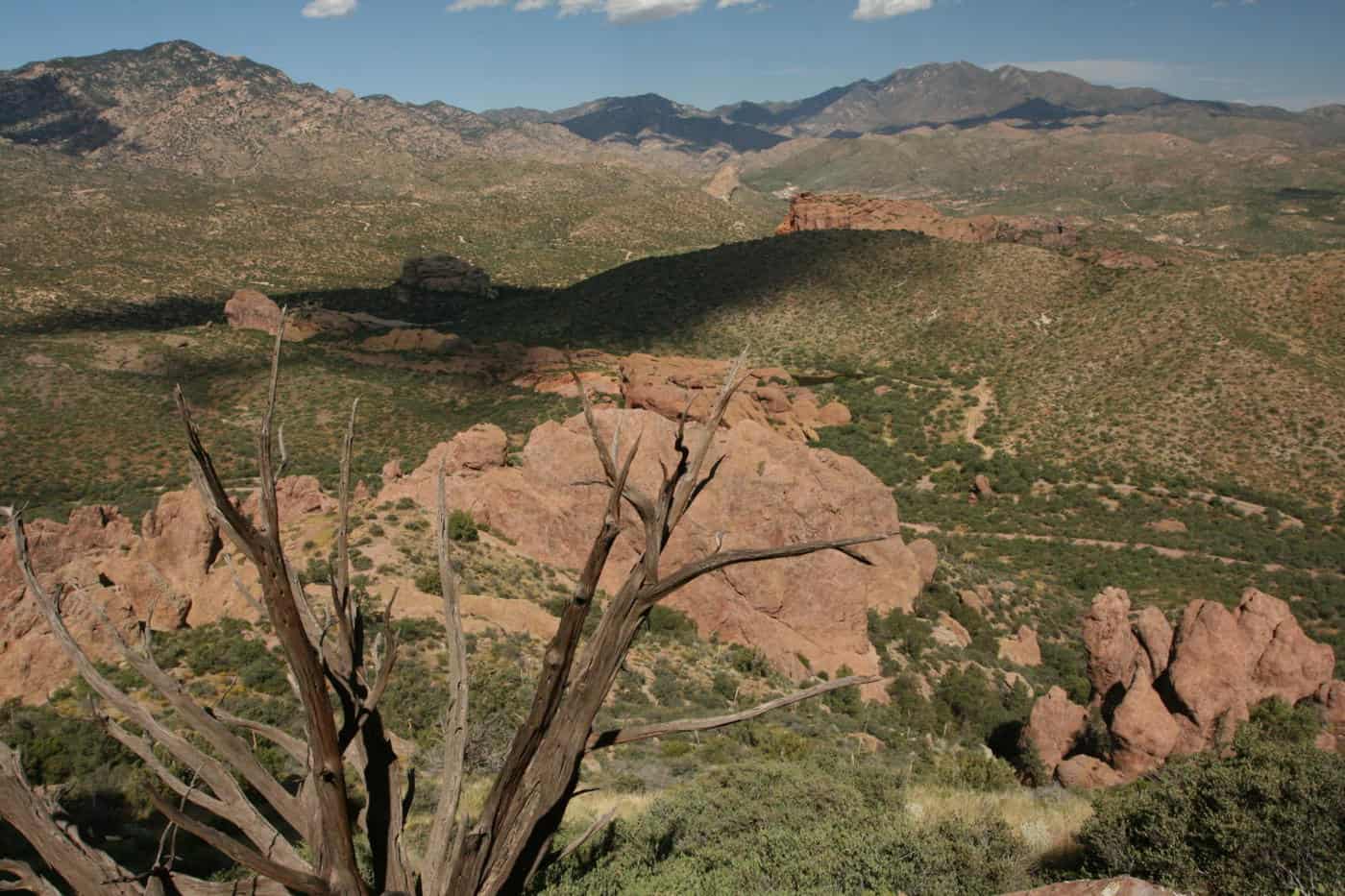
The Santa Teresas are a network of rugged mountains with bald summits, deep canyons, and sprawling mesas (largely Holdout and Mud Spring mesas) with elevation ranging from less than 4,000 feet to 7,481 feet on the summit of Cottonwood Peak. With abundant caves and alcoves hollow into eroded cliffs with picturesque formations, the very rugged Holdout Canyon typifies the Santa Teresas. Thick chaparral vegetation covers the terrain with stands of ponderosa pine and Douglas-fir on the north flanks and the crest of Cottonwood Peak.
APACHE-SITGREAVES NATIONAL FORESTS
The Apache-Sitgreaves National Forests cover 2 million acres of land and runs along the Mogollon Rim and the White Mountains in east-central Arizona and into the U.S. state of New Mexico. Apache-Sitgreaves has over 400 species of wildlife and is known for elk and mule deer hunting.
The Apache-Sitgreaves National Forests are two 2.76-million-acre (11,169 km2) United States National Forests which run along the Mogollon Rim and the White Mountains in east-central Arizona and into the U.S. state of New Mexico.
Apache-Sitgreaves has over 400 species of wildlife. The forest is home to most big game animals, such as antelope, elk, deer, bighorn sheep, and turkey, as well as a variety of songbirds, waterfowl, small mammals, fish, amphibians and reptiles.
CONONINO NATIONAL FOREST
The Cononino National Forest is located just south of Flagstaff and covers nearly 1.9 million acres of land and offers a range of hunting opportunities with substantial wilderness areas with elk hunting units providing access to mature bulls.
The forest is also known for its plentiful wildlife. Large herds of elk roam the forests and edgelands. Bald eagles and ospreys live and hunt around the lakes. Pronghorn antelope graze the prairies.
